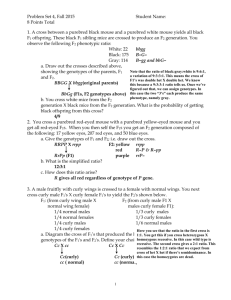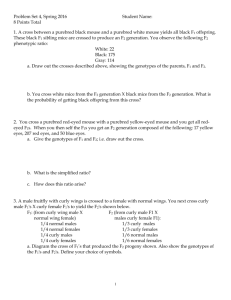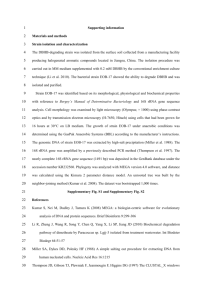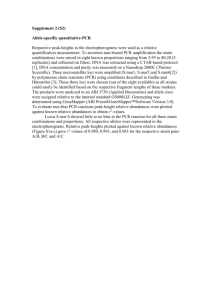1/16 yellow-bodied, white
advertisement
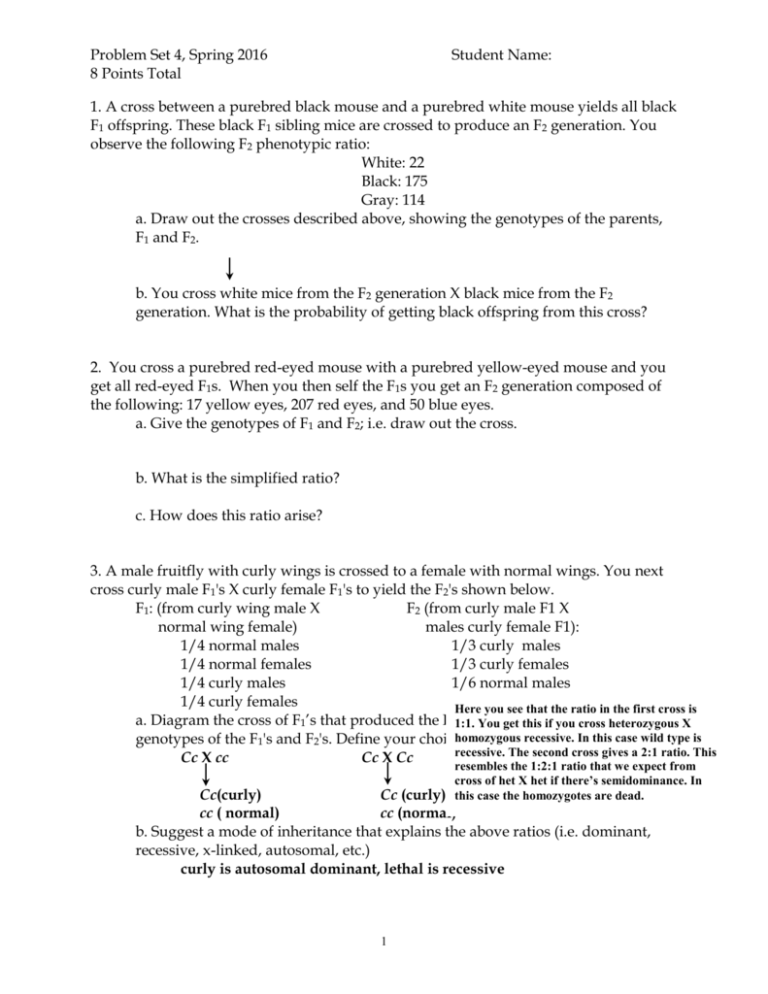
Problem Set 4, Spring 2016 8 Points Total Student Name: 1. A cross between a purebred black mouse and a purebred white mouse yields all black F1 offspring. These black F1 sibling mice are crossed to produce an F2 generation. You observe the following F2 phenotypic ratio: White: 22 Black: 175 Gray: 114 a. Draw out the crosses described above, showing the genotypes of the parents, F1 and F2. b. You cross white mice from the F2 generation X black mice from the F2 generation. What is the probability of getting black offspring from this cross? 2. You cross a purebred red-eyed mouse with a purebred yellow-eyed mouse and you get all red-eyed F1s. When you then self the F1s you get an F2 generation composed of the following: 17 yellow eyes, 207 red eyes, and 50 blue eyes. a. Give the genotypes of F1 and F2; i.e. draw out the cross. b. What is the simplified ratio? c. How does this ratio arise? 3. A male fruitfly with curly wings is crossed to a female with normal wings. You next cross curly male F1's X curly female F1's to yield the F2's shown below. F1: (from curly wing male X F2 (from curly male F1 X normal wing female) males curly female F1): 1/4 normal males 1/3 curly males 1/4 normal females 1/3 curly females 1/4 curly males 1/6 normal males 1/4 curly females 1/6 females Herenormal you see that the ratio in the first cross is a. Diagram the cross of F1’s that produced the F21:1. progeny the X You get shown. this if youAlso cross show heterozygous homozygous recessive. In this case wild type is genotypes of the F1's and F2's. Define your choice of symbols. recessive. The second cross gives a 2:1 ratio. This Cc X cc Cc X Cc resembles the 1:2:1 ratio that we expect from cross of het X het if there’s semidominance. In this case the homozygotes are dead. Cc(curly) Cc (curly) cc ( normal) cc (normal) b. Suggest a mode of inheritance that explains the above ratios (i.e. dominant, recessive, x-linked, autosomal, etc.) curly is autosomal dominant, lethal is recessive 1 Problem Set 4, Spring 2016 8 Points Total Student Name: 4. There are two naturally occurring strains of the octopus, T. bastinae, those with short tentacles and blue spots and those with long tentacles and yellow spots. You cross a true-breeding short tentacle, blue spotted octopus and a true-breeding long tentacled, yellow spotted octopus. The F1’s all have long tentacles and green spots. You cross the F1’s amongst themselves and find the following F2’s: 3/16 long tentacle, yellow spotted 1/16 short tentacle, yellow spotted 6/16 long tentacle, green spotted 2/16 short tentacle, green spotted 3/16 long tentacle, blue spotted 1/16 short tentacle, blue spotted L–BB llBB L–Bb llBb L–bb llbb Again the key is in the ratios. You see that the ratio of long:short is 3:1, showing dominant/recessive relationship and the ratio of yellow:green:blue is 1:2:1, showing semidominance. a. What is the genotype of each of the F2 progeny? Note that long:short is 3:1 and yellow:green:blue is 1:2:1 suggesting that long is dominant to short and spot colors shows semidominance. b. If you cross short tentacle, blue spotted F2 by short tentacle, green spotted F2, what will the offspring look like? llbb X llBb gives llBb (short, green) and llbb (short, blue) in 1:1 ratio 5. In the jungles of Jamaica lives a colorful species of beetle K. badgerae. Three strains of K. badgerae are known. Strain 1 has red wing covers, strain 2 has orange wing covers and strain 3 has green wing covers. You take members of each strain back to the lab and perform the following crosses, which yield the results shown. strain 1 X strain 2: strain 1 X strain 3: strain 2 X strain 3: all green 1/2 red and 1/2 green 1/2 orange and 1/2 green a. What are the genotypes of the three strains? strain 1 _RR_ strain 2 _rr_ strain 3 _Rr__ 2 The first cross shows that red X orange gives green. There are several ways in which this might occur. The second cross shows that either strain 1 or strain3 is heterozygous because we see a 1:1 ration. Likewise with the third cross, showing the it is strain 3 that must be heterozygous. Problem Set 4, Spring 2016 8 Points Total Student Name: b. What phenotypes do you expect from a cross of strain 3 X strain 3? Please include the relative frequencies of each phenotype. Rr X Rr gives: 1/4 RR (red) 1/2 Rr (green) 1/4 rr (orange) 6. You discover a new substance (Substance E) that is involved in the production of zigzag stripes. You are interested in understanding the genetic basis for substance E synthesis, and therefore used a genetic screen to identify 8 mutations (numbered 1 – 8) that prevent substance E synthesis. You cross homozygous recessive parents in all possible pairwise combinations to generate the results presented in the table. 1 2 3 4 5 6 7 8 1 + + + + + 2 + + + + + - 3 + + + + + 4 + + + + + 5 + + + + + + + 6 + + + + + - 7 + + + + + + + 8 + + + + + - a. What is the name for this type of cross and what type of information does it provide? complementation test; tests for allelism. b. How many genes are involved in the production of Substance E? 4 c. Show which mutations belong to each gene, and give each gene a symbol. gene A: 1, 3, 4 gene C: 5 gene B: 2, 6, 8 gene D: 7 d. Shown below is the biochemical pathway leading to production of substance E. You assay for each of the intermediates in each of the eight mutants. A + means that the compound was detected in mutant cells whereas a – indicates that it was not. Write above each arrow the gene(s) that encode the enzyme(s) responsible for that step of substance E synthesis. mutants 1 2 3 4 5 6 7 8 A + + + + + + + + B + - + + + - + 3 Problem Set 4, Spring 2016 8 Points Total C D E + A - + - gene B + - + + B Student Name: - gene D - C gene A D gene C Substance E 7. During your investigations of frog species in Costa Rica you find two strains of the splendid poison dart from D. webbae. Strain 1 has yellow bodies and red eyes. Strain two has blue bodies and white eyes. You cross strain 1 females with strain 2 males. The resulting F1's all have green bodies and red eyes. You cross F1's to produce the following F2's at the frequencies indicated: 1/4 green-bodied, red-eyed females 1/8 yellow-bodied, red-eyed females 1/8 blue-bodied, red-eyed females 1/8 green-bodied, red-eyed males 1/8 green-bodied, white-eyed males 1/16 yellow-bodied, red-eyed males 1/16 yellow-bodied, white-eyed males 1/16 blue-bodied, red-eyed males 1/16 blue-bodied, white-eyed males BbXGXG or g BBXGXG or g bbXGXG or g BbXGY BbXgY BBXGY BBXgY bbXGY bbXgY a. Please give the genotypes of the F2 animals in the space provided. Note that yellow:green:blue is 1:2:1 (suggesting semidominance) and red female:red male:white male is 2:1:1 suggesting X-linkage. b. Please give the genotypes, phenotypes and expected frequencies of the different classes of offspring that would result from a cross of greeen-bodied, red-eyed males X yellow-bodied, red eyed- females. Here are the two crosses: BbXGY X BBXGXG (1/2 are this) BbXGY X BBXGXg (1/2 are this) 4 Problem Set 4, Spring 2016 8 Points Total Student Name: If you write out the genotypes that can result from these two crosses and their relative frequencies, and if you notice that some of them produce the same phenotype, you should be able to come up with the answer below. yellow-bodied, red-eyed female 1/4 yellow-bodied, red-eyed male 3/16 green-bodied, red-eyed female 1/4 green-bodied, red-eyed male 3/16 yellow-bodied, white-eyed male 1/16 green-bodied, white-eyed male 1/16 8. While researching methods of year-round farming, you isolate 6 independent mutations that allow soybeans to withstand freezing. All 6 lines 1 2 3 4 5 were intercrossed, and you 1 – + + – + obtain the following results (+ 2 + – + + + indicates wild type plants, – 3 + + – + – 4 – + + – + indicates cold resistant): A. What is the name of this type of test? Complementation test 5 6 7 + + + + + – – + + + + + – + + 6 + + + + + – + B. How many individual genes were identified? Which mutations are allelic? 4 genes, 1 and 4 are allelic, 2 represents a second gene, 3 and 5 are allelic and represent a third gene and 6 represents a fourth gene. C. In further studies, mutation #7 is also found to cause resistance to freezing. It is determined that mutations #2 and 7 are allelic. Add the complementation test results in the space provided in the chart above. 5 7 + – + + + + –
